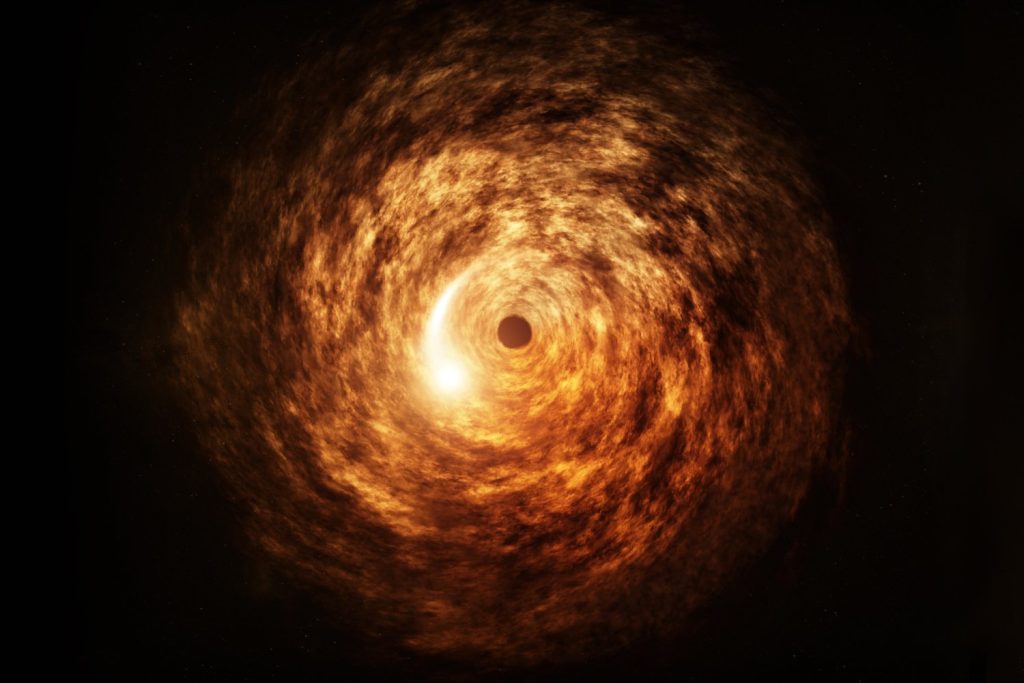Milky Way’s Black Hole Just Lit Up in a Way We’ve Never Seen Before – Gizmodo

Astronomers have detected a mid-infrared flare from the supermassive black hole at the heart of the Milky Way galaxy for the very first time, and it’s shedding new light on the complex physics driving these energetic outbursts.The flare—a burst of energy that changed in intensity as the black hole’s magnetic field lines interacted—fills in an area of black hole observations that previously eluded scientists. However, questions remain about the chaotic environment near the heart of the abyssal object.The team’s detection and modeling of the flare is accepted for publication in the Astrophysical Journal Letters and is currently available on the pre-print server arXiv. The findings were presented today at the 245th meeting of the American Astronomical Society in National Harbor, Maryland.The black hole, called Sagittarius A* (pronounced A-star), is an object about four million times the mass of our Sun and sits at the core of the Milky Way. Black holes are ultra-dense objects with gravitational fields so fierce that not even light can escape their bounds beyond a point called the event horizon. In the artist’s concept at the beginning of this article, the black hole is the dark chasm at the core of a swirl of material.“For over 20 years, we’ve known what happens in the radio and Near-infrared (NIR) ranges, but the connection between them was never 100% clear,” said Joseph Michail, one of the paper’s lead authors and a researcher at the Smithsonian Astrophysical Observatory, part of the Center for Astrophysics | Harvard & Smithsonian, in a center release. “This new observation in mid-IR fills in that gap.”Mid-infrared light has longer wavelengths than visible light but shorter wavelengths than radio waves. It also happens to be one of the Webb Space Telescope’s specialties, which the telescope captures with its Mid-InfraRed Instrument (MIRI).Cooling electrons in the black hole’s accretion disk—the superheated, glowing matter surrounding the object—release energy to power the flares. The electrons’ role in black hole flares was revealed at mid-infrared wavelengths, and according to Michail, offer another piece of evidence about what fuels the flares.The detection and the team’s model offer more clarity—and complexity—to the portrait of our galaxy’s central black hole. Modeling black hole physics and directly imaging the objects go hand-in-hand in getting us closer to understanding the physics that underpin some of the most massive and remarkable objects in our universe.The Event Horizon Telescope Collaboration directly imaged a black hole for the first time in April 2019; the collaboration followed up that feat with the first direct image of Sagittarius A* in May 2022, though last year a group of researchers suggested that image was flawed.Last year, the collaboration—whose telescope comprises a network of radio telescope observatories around the world—yielded the highest-resolution observations obtained from the planet. The work indicated that, at certain wavelengths, future black hole images could be 50% sharper than previously published images.It may take more observations to verify whether cooling, high-energy electrons are indeed responsible for the flares. But the finding offers a new twist in the tale of black holes, and showcases the role the Webb Space Telescope can play in demystifying the massive objects.
AstrophysicsBlack holesInfrared telescopeswebb space telescope
Get the best tech, science, and culture news in your inbox daily.
News from the future, delivered to your present.
Please select your desired newsletters and submit your email to upgrade your inbox.
A star system 5,000 light-years from Earth, surrounded by layers of dust, could help scientists better understand the final stages of stellar life.
Researchers found far more hidden black holes than previously known, indicating plenty of behemoths lurking in thick clouds of gas and dust.
The cutting-edge observatory is charged with seeing some of the earliest visible light, and the recent image achieves a new milestone in stellar astronomy.
New images from Webb Space Telescope reveal massive, ancient spiral galaxies.
Perplexing data in the early 2000s raised questions about how planetary formation began in the universe, and new data from Webb provides some answers.
An ancient black hole had to take it easy after gorging itself on its local galaxy, offering hints at the exotic objects’ evolution.
Best of CES 2025 Awards ➜We may earn a commission when you buy through links on our sites.
©2025 GIZMODO USA LLC. All rights reserved.Mode
Follow us
Mode
Follow us
Source: https://gizmodo.com/milky-ways-black-hole-just-lit-up-in-a-way-weve-never-seen-before-2000549973






